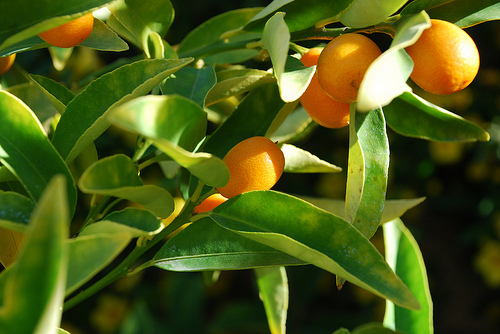Gardening Question From Andrew:
I have 3 kumquat trees in my garden area. Two are 3 years old, one is about 5 years old. My soil is very low in N and K. A lot of 5 year old’s leaves are somewhat yellow. I do feed on a regular basis with organic EB Stone citrus fert. I have a single ring of 1 gph – 18″spacing- emitter tubing around each tree. (So roughly a total of 4 gph capacity per tree. I live in zone 9B which includes 2 months of very hot weather — several conseq. days >100. The trees bloom profusely but do not set fruit. Many of the leaves are cupping. I water the trees about 1 hour every two weeks. Am I possibly not watering enough? Or, too much. Sorry for the sketchy facts — best my pea brain is capable of. Absolutely LOVE your posts.
Answer From Pat:
Glad you enjoy my posts. Thanks for telling me.—Now to your kumquat: Cupped leaves can be caused by insects, but most likely were caused by the very hot temperatures you recently underwent. Lack of trees setting fruit despite flowering is most likely caused by lack of bees. If I were you, I would purchase a size 8 red sable watercolor paint brush and in the early morning after the dew dries off go out there and play like a bee twirling the brush inside flowers and going from flower to flower all over the tree. Do this several times until you see plenty of fruit have set.
A word of caution regarding your irrigation system: Do not water too close to the trunks of the trees. Be sure to relocate the irrigation under the drip lines (tips of branches) of the trees. Unfortunately, drip watering is not the optimum method of irrigating citrus, since the roots are located right under the soil and begin about a foot from the trunk and extend out to the dripline and even beyond it. Never cultivate under the tree even to remove weeds since this will make all the fruit fall off.
It sounds as if you are giving enough fertilizer to compensate for lack of nitrogen and potassium (N and K) in your native soil, but if you ever fear pest problems, also cover the ground under the tree with earthworm castings. Earthworm castings are not a fertilizer since they don’t contain much nitrogen, but they help in pest control because they are filled with chitinase which is an enzyme that destroys chitin, which is the substance out of which the exoskeletons of insects are made.
PS
By accident I noticed your question once again in my computer. I did not mention yellow leaves. That sounds like inadequate nitrogen. Most people starve their home-grown citrus trees, so try upping the nitrogen and water it in well, but wait until next year. Not sure where you live but in Southern California the time to begin feeding or apply the whole amount for the year is late January. I do not know the size of your trees, so refer to my month-by-month books (available in digital form) for the answer. See January in the year 2000 or 2010 editions of Pat Welsh’s Southern California Gardening Month by Month completely revised and updated (year 2000) or PW’s Southern CA Organic Gardening Month by Month (2010). You can also purchased used copies. Tragically Chronicle Books has allowed my book to go out of print. Gardeners loved it. Unfortunately, despite my huge book sales at talks, many gardeners were so wedded to their beloved older editions they never realized they needed the up-dated versions. Drought and water shortages might also have been a problem since my books were encyclopedic and covered all plants not only drought-resistant ones.
Photo by Joye~ 





